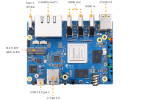I have to admit the multichannel I2S input is pretty cool and was much more plug and plug than I ever expected, although that is largely due to folks way more knowledgeable than me.
I did some more testing today and really think an Apple TV + HDMI to I2S Extractor + RPi5 + CamillaDSP + multichannel USB DAC (preferably with some ability to clock to an external SPDIF clock) is a really nice AVR alternative.
Today I reduced chunk size to 256 at 48 kHz with no rate adjust or resampling. I played a movie for two hours and buffer level stayed at 340 +/- 5, there were no buffer under runs and no lip sync issues.
CamillaDSP will go in to STALLED state if the Apple TV is powered off, but it comes right back when the Apple TV is powered on. I plan on seeing how it does powered off overnight but so far it is really well behaved. There are no nasty pops or noises when powering the RPi on / off either. Although part of this may be due to how well behaved the MOTU Ultralite Mk5 is when it loses clock lock.
Michael
I did some more testing today and really think an Apple TV + HDMI to I2S Extractor + RPi5 + CamillaDSP + multichannel USB DAC (preferably with some ability to clock to an external SPDIF clock) is a really nice AVR alternative.
Today I reduced chunk size to 256 at 48 kHz with no rate adjust or resampling. I played a movie for two hours and buffer level stayed at 340 +/- 5, there were no buffer under runs and no lip sync issues.
CamillaDSP will go in to STALLED state if the Apple TV is powered off, but it comes right back when the Apple TV is powered on. I plan on seeing how it does powered off overnight but so far it is really well behaved. There are no nasty pops or noises when powering the RPi on / off either. Although part of this may be due to how well behaved the MOTU Ultralite Mk5 is when it loses clock lock.
Michael

